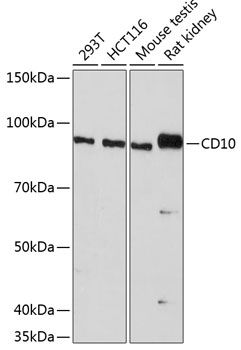Cell Biology Antibodies 17
Anti-CD10 Antibody (CAB19007)
- SKU:
- CAB19007
- Product Type:
- Antibody
- Reactivity:
- Human
- Reactivity:
- Mouse
- Reactivity:
- Rat
- Host Species:
- Rabbit
- Isotype:
- IgG
- Research Area:
- Cell Biology
Description
| Antibody Name: | Anti-CD10 Antibody |
| Antibody SKU: | CAB19007 |
| Antibody Size: | 20uL, 50uL, 100uL |
| Application: | WB |
| Reactivity: | Human, Mouse, Rat |
| Host Species: | Rabbit |
| Immunogen: | A synthesized peptide derived from human CD10 |
| Application: | WB |
| Recommended Dilution: | WB 1:500 - 1:2000 |
| Reactivity: | Human, Mouse, Rat |
| Positive Samples: | 293T, HCT116, Mouse testis, Rat kidney |
| Immunogen: | A synthesized peptide derived from human CD10 |
| Purification Method: | Affinity purification |
| Storage Buffer: | Store at -20°C. Avoid freeze / thaw cycles. Buffer: PBS with 0.02% sodium azide, 0.05% BSA, 50% glycerol, pH7.3. |
| Isotype: | IgG |
| Sequence: | Email for sequence |
| Gene ID: | 4311 |
| Uniprot: | P08473 |
| Cellular Location: | |
| Calculated MW: | 100kDa |
| Observed MW: | 90kDa |
| Synonyms: | CALLA, CD10, CMT2T, NEP, SCA43, SFE, MME |
| Background: | This gene encodes a common acute lymphocytic leukemia antigen that is an important cell surface marker in the diagnosis of human acute lymphocytic leukemia (ALL). This protein is present on leukemic cells of pre-B phenotype, which represent 85% of cases of ALL. This protein is not restricted to leukemic cells, however, and is found on a variety of normal tissues. It is a glycoprotein that is particularly abundant in kidney, where it is present on the brush border of proximal tubules and on glomerular epithelium. The protein is a neutral endopeptidase that cleaves peptides at the amino side of hydrophobic residues and inactivates several peptide hormones including glucagon, enkephalins, substance P, neurotensin, oxytocin, and bradykinin. This gene, which encodes a 100-kD type II transmembrane glycoprotein, exists in a single copy of greater than 45 kb. The 5' untranslated region of this gene is alternatively spliced, resulting in four separate mRNA transcripts. The coding region is not affected by alternative splicing. [provided by RefSeq, Jul 2008] |
| UniProt Protein Function: | CD10: Thermolysin-like specificity, but is almost confined on acting on polypeptides of up to 30 amino acids. Biologically important in the destruction of opioid peptides such as Met- and Leu-enkephalins by cleavage of a Gly-Phe bond. Able to cleave angiotensin-1, angiotensin-2 and angiotensin 1-9. Involved in the degradation of atrial natriuretic factor (ANF). Displays UV- inducible elastase activity toward skin preelastic and elastic fibers. Inhibited in a dose dependent manner by opiorphin. Belongs to the peptidase M13 family. |
| UniProt Protein Details: | Protein type:EC 3.4.24.11; Membrane protein, integral; Protease Chromosomal Location of Human Ortholog: 3q25.2 Cellular Component: axon; brush border; cytoplasm; dendrite; focal adhesion; plasma membrane; synapse; synaptic vesicle Molecular Function:endopeptidase activity; exopeptidase activity; metalloendopeptidase activity; metallopeptidase activity; peptide binding; protein binding; zinc ion binding Biological Process: angiotensin maturation; beta-amyloid metabolic process; creatinine metabolic process; kidney development; peptide metabolic process; proteolysis; sensory perception of pain Disease: Membranous Nephropathy, Susceptibility To |
| NCBI Summary: | This gene encodes a common acute lymphocytic leukemia antigen that is an important cell surface marker in the diagnosis of human acute lymphocytic leukemia (ALL). This protein is present on leukemic cells of pre-B phenotype, which represent 85% of cases of ALL. This protein is not restricted to leukemic cells, however, and is found on a variety of normal tissues. It is a glycoprotein that is particularly abundant in kidney, where it is present on the brush border of proximal tubules and on glomerular epithelium. The protein is a neutral endopeptidase that cleaves peptides at the amino side of hydrophobic residues and inactivates several peptide hormones including glucagon, enkephalins, substance P, neurotensin, oxytocin, and bradykinin. This gene, which encodes a 100-kD type II transmembrane glycoprotein, exists in a single copy of greater than 45 kb. The 5' untranslated region of this gene is alternatively spliced, resulting in four separate mRNA transcripts. The coding region is not affected by alternative splicing. [provided by RefSeq, Jul 2008] |
| UniProt Code: | P08473 |
| NCBI GenInfo Identifier: | 128062 |
| NCBI Gene ID: | 4311 |
| NCBI Accession: | P08473.2 |
| UniProt Secondary Accession: | P08473,Q3MIX4, A8K6U6, D3DNJ9, |
| UniProt Related Accession: | P08473 |
| Molecular Weight: | 85,514 Da |
| NCBI Full Name: | Neprilysin |
| NCBI Synonym Full Names: | membrane metallo-endopeptidase |
| NCBI Official Symbol: | MME |
| NCBI Official Synonym Symbols: | NEP; SFE; CD10; CALLA; CMT2T |
| NCBI Protein Information: | neprilysin |
| UniProt Protein Name: | Neprilysin |
| UniProt Synonym Protein Names: | Atriopeptidase; Common acute lymphocytic leukemia antigen; CALLA; Enkephalinase; Neutral endopeptidase 24.11; NEP; Neutral endopeptidase; Skin fibroblast elastase; SFE; CD_antigen: CD10 |
| Protein Family: | Neprilysin |
| UniProt Gene Name: | MME |
| UniProt Entry Name: | NEP_HUMAN |






